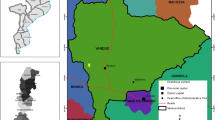Abstract
During the last five years, Bactericera cockerelli Sulc. has caused significant economic losses in potato production in Mexico, due to the purple top and zebra chip diseases, since it acts as the vector of Candidatus Liberibacter psyllaurous. Despite its importance as a vector of serious potato diseases, the knowledge of its spatial distribution behavior, which could improve the efficiency of control measures, is entirely lacking. The main objective of this work was to compare the spatial distribution of the immature and adult stages of B. cockerelli obtained in a potato field by means of transect and quadrant sampling techniques and of geostatistics tools that allow the visualization of its spatial distribution in the field. Transect and quadrant samplings showed that the immature stages (eggs and nymphs) of B. cockerelli present a clustered distribution. The validation of the achieved semivariograms in the three dates of sampling corroborated the aggregated distribution of immatures and adults of the insect. The maps obtained in the sampling by using the quadrant or the transect approaches reflect the aggregated structure of the insect populations which did not infest 100% of the plot area. This allowed us to identify infested and free areas, what will aid in decisions for selecting alternatives of control.




Similar content being viewed by others
References
Blom EP, Fleischer SJ (2001) Dynamics in the spatial structure of Leptinotarsa decemlineata (Coleoptera: Chrysomelidae). Environ Entomol 30:350–364
Boiteau G, Bradley J, Van Duyn J, Stinner R (1979) Bean leaf beetle: micro-spatial patterns and sequential sampling of field populations. Environ Entomol 8:1139–1104
Cambardella C, Moorman T, Novak J, Parkin T, Karlen D, Turco R, Konopka A (1994) Field scale variability of soil properties in central Iowa soils. Soil Sci Soc Am J 58:1501–1511
CESAVEM (2007) Manual operativo para la atención de la paratrioza Bactericera cockerelli Sulc. México, Comité Estatal de Sanidad Vegetal del Estado de México–SAGARPA, p 52
Englund E, Sparks A (1988) GEO-EAS (Geostatistical environmental assessment software) User´s guide, U.S. Environmental Protection Agency Document EPA/600/4-88/033, Environmental Monitoring Systems Laboratory, Las Vegas, NV, USA
Fleischer S, Weisz R, Smilowitz Z, Midgarden D (1997) Spatial variation in insect populations and site-specific integrated pest management, p. 101–130. In: Pierce FJ, Sadler EJ (eds) The state of site-specific management for agriculture. ASA, Madison, p 430p
Fleischer J, Blom EP, Weisz R (1999a) Sampling in precision IPM: when the objetive is a map. Phytopathology 89:115–118
Fleischer S, Blom EP, Emmen D, Hower A (1999b) Dynamics in the spatial continuity of insect density. Fourth International Conference on Precision Agriculture, New York, 683p
Garzón T (2004) El “pulgón saltador” o la paratrioza, una amenaza para la horticultura de Sinaloa. Memoria de Taller sobre Paratrioza cockerelli Sulc. como plaga y vector de fitoplasmas en hortalizas, Culiacán, Sinaloa, México, 100p
Hansen AK, Trumble JT, Stouthamer R, Paine TD (2008) New Huanglongbing (HLB) Candidatus species, “C. Liberibacter psyllaurous” found to infect tomato and potato is vectored by the psyllid Bactericerca cockerelli (Sulc). Appl Environ Microbiol 74:5862–5865
Hulbert S (1990) Spatial distribution of the montane unicorn. Oikos 58:257–271
Liebhold A, Sharov A (1998) Testing for correlation in the presence of spatial autocorrelation in insect count data. Population and community ecology for insect management and conservation, 253p
Liebhold A, Zhang X, Hohn M, Elkinton J, Ticehurst M, Benzon G, Campbell R (1991) Geostatistical analysis of gypsy moth (Lepidoptera: Lymantriidae) egg mass populations. Environ Entomol 20:1407–1417
Munyaneza JE, Crosslin JM, Upton JE (2007a) Association of Bactericera cockerelli (Homoptera: Psyllidae) with “Zebra Chip”, a new potato disease in southwestern United States and Mexico. J Econ Entomol 100:656–663
Munyaneza JE, Goolsby JA, Crosslin JM, Upton JE (2007b) Further evidence that zebra chip potato disease in the lower Rio Grande Valley of Texas is associated with Bactericera cockerelli. Subtrop Plant Sci 59:30–37
Oliver M, Webster R (1991) How geostatistics can help you. Soil Use Manage 7:206–217
Ramirez JF, Porcayo E (2008) Distribución espacial de las ninfas de Jacobiasca líbica (Hemiptera: Cicadellidae) en un viñedo en Andalucía, España. Rev Col Entomol 34:169–175
Rossi R, Mulla J, Journel G, Franz H (1992) Geostatical tools for modeling and interpreting ecological spatial dependence. Ecol Monogr 62:277–314
Samper FJ, Carrera J (1996) Geoestadística: aplicaciones a la hidrología subterránea, 2nd edn. Barcelona, Centro Internacional de Métodos en Ingeniería, 484p
Sawyer J (1989) Inconstancy of Taylor´sb: simulated sampling with different quadrat sizes and spatial distributions. Res Popul Ecol 31:11–24
Sciarretta A, Trematerra P, Baumgärtner J (2001) Geostatistical análisis of Cydia funebrana (Lepidoptera: Tortricidae) pheromone trap catches at two spatial scales. Amer Entomol 47:174–184
Speight M, Hails R, Gilbert M, Foggo A (1998) Horse chestnut scale (Pulvinaria regalis) (Homoptera: Coccidae) and urban host tree environment. Ecol 79:1503–1513
Taylor L (1984) Assessing and interpreting the spatial distributions of insect populations. Annu Rev Entomol 29:321–357
Author information
Authors and Affiliations
Corresponding author
Additional information
Edited by Wesley AC Godoy – ESALQ/USP
Rights and permissions
About this article
Cite this article
Ramírez-Davila, J.F., Porcayo-Camargo, E., Sánchez-Pale, J. et al. Spatial Behavior Comparison of Bactericera cockerelli Sulc. (Hemiptera: Triozidae) in Mexico. Neotrop Entomol 41, 9–16 (2012). https://doi.org/10.1007/s13744-012-0019-y
Received:
Accepted:
Published:
Issue Date:
DOI: https://doi.org/10.1007/s13744-012-0019-y




